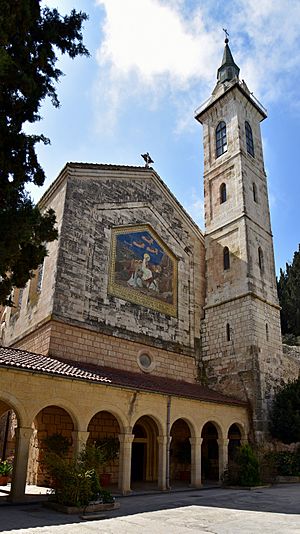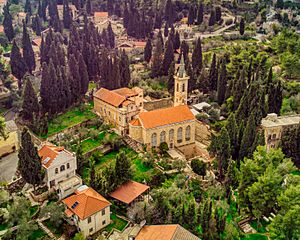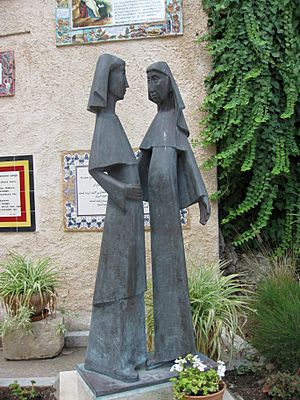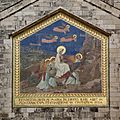Church of the Visitation facts for kids
Quick facts for kids Church of the Visitation |
|
|---|---|

Exterior view
|
|
| Religion | |
| Affiliation | Roman Catholic |
| Leadership | Franciscan Order |
| Location | |
| Location | Ein Karem, Jerusalem |
| Palestine grid | 1651/1302 |
| Architecture | |
| Architect(s) | Antonio Barluzzi |
| Completed | 1955 |
The Church of the Visitation is a special Catholic church. It is found in Ein Karem, a village near Jerusalem. This church honors a very important event in Christian history. It remembers when Mary, the mother of Jesus, visited her cousin Elizabeth. Elizabeth was the mother of John the Baptist. People believe that Mary sang her famous song of praise, the Magnificat, at this very spot. The Magnificat is one of the oldest songs dedicated to Mary.
Contents
The Story of the Visitation
The Bible tells us that Mary went to a "town in the hill country of Judea" to visit Elizabeth. It does not give the exact name of the town. However, for a long time, people have believed that Ein Karem is the place where Elizabeth and her husband, Zechariah, lived. An old story says that Empress Helena of Constantinople, the mother of Emperor Constantine I, built the first church in Ein Karem. She believed this was Zechariah's home.
Uncovering Ancient History
Archaeologists are like history detectives. They dig up old sites to learn about the past. Bellarmino Bagatti led an important dig at the Church of the Visitation site in 1938.
Discoveries from the Byzantine Era
During the digs, archaeologists found a Byzantine water tank in the church courtyard. Even more exciting, they found parts of a Byzantine chapel. This older chapel was built before the later churches on the same spot.
The Crusader Period
When the Crusaders came to the Holy Land, Ein Karem became very important for pilgrims. Three places in the village were linked to the life of John the Baptist. These included a cave, a hill, and the village's main water source. People believed these spots were where Mary and Elizabeth met, where Zechariah and Elizabeth lived, where John was born, and where Elizabeth and John hid.
The Crusaders built two main churches in Ein Karem. These churches are now known as the Church of St John the Baptist and the Church of the Visitation. At the site of the Church of the Visitation, the Crusaders built a two-story church. They dedicated it to the meeting of Elizabeth and Mary. This church was built right over the ancient ruins they had found.
Later Times: Ayyubid and Mamluk Periods
After the Crusaders left the Holy Land, the church slowly fell apart. For a while in the 1300s, Armenian monks took care of it. But by 1480, a traveler named Felix Fabri wrote that the church was in ruins. He said the altars were broken, and plants grew on the walls and roofs. He described it as a "ruined house."
The Ottoman Era
The Franciscans, a group of Catholic monks, bought the land with the ruined Crusader church in 1679. It took a long time, but in 1862, the Franciscans finally started rebuilding the lower part of the church.
Building the Modern Church
In 1937, the Franciscans explored the grounds more. The design and building of the upper part of the church began in 1938. An Italian architect named Antonio Barluzzi finished the work in 1955.
Exploring the Church
The Church of the Visitation has many interesting parts to explore.
Courtyard and Outside Areas
In the church courtyard, you can see a statue of Mary and Elizabeth meeting. On a wall opposite the entrance to the lower church, there are 42 ceramic tablets. Each tablet has the words of the Magnificat written in a different language. The front of the upper church has a beautiful mosaic. It shows Mary visiting Elizabeth. Next to the main church, there is a Crusader hall from the 12th century that is still in good condition.
The Lower Church
The lower church has a narrow, arched room from the Middle Ages. At the end of this room is a well. People believe that Elizabeth and baby John drank from this well. The well is connected to an old Roman or Byzantine water pipe. You can also see parts of the ancient church and beautiful mosaic floors here.
Near the entrance to this old room, there is a rock with a crack in it. This is called the "Rock of Concealment." The story says that the mountain opened up here to hide Elizabeth and baby John from Herod's soldiers. This story comes from an old book called the Protoevangelium of James.
Inside the lower church, there are frescoes, which are paintings done on wet plaster. These paintings show Zechariah at the altar, Mary visiting Elizabeth, and Elizabeth hiding her son during the massacre.
The Upper Church
The walls of the upper church are also decorated with frescoes. On the southern wall, there are five paintings:
- The Council of Ephesus (431 AD), where Mary was called Theotokos, meaning "Mother of God."
- Mary protecting Christians with her cloak, based on an old hymn.
- The Wedding at Cana, where Jesus turned water into wine.
- The Battle of Lepanto (1571), a naval battle where Catholic forces won against the Ottomans. People believed Mary helped them win.
- Duns Scotus, a Franciscan scholar, arguing for the Immaculate Conception of Mary.
Behind the altar, there is a fresco showing Mary arriving in Judea. A Franciscan leader is shown presenting a model of the church to her.
Verses from the Magnificat are painted on the church columns. In the corners, you can see paintings of the four main virtues: wisdom, justice, courage, and moderation. Around the windows on the left side, there are paintings of important Christian writers who wrote about Mary. The ceiling is painted in a style popular in Tuscany in the 1300s.
Images for kids
See also
 In Spanish: Iglesia de la Visitación para niños
In Spanish: Iglesia de la Visitación para niños












